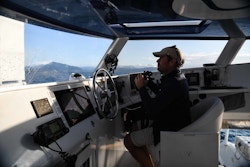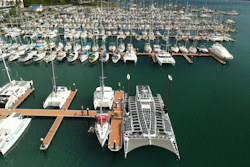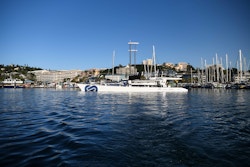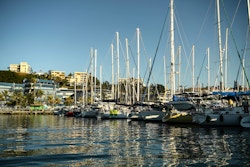New Caledonia, France
After more than 25 days of sailing and 3,366 nautical miles across the Pacific Ocean, our ship dropped anchor in Noumea for the first stopover in New Caledonia. During this navigation, our crew has crossed the 40,000 nautical mile mark since the beginning of the Odyssey!
Coming from: Big Island, Hawaii
Weather conditions: Sunny
Time of arrival: 12:00 AM
Travelled distance: 6233,832

Our floating laboratory arrived in the archipelago of New Caledonia after 25 days of navigation at an average speed of 5.6 knots. The crossing was punctuated by changing weather conditions in an ocean that covers one third of our planet's surface.
From spectacular moonlight to the cleaning of the solar panels, between pride of what has been done and nostalgia to leave the sea, discover the highlights of this "first of its kind" navigation told by the crew.
The first Pacific crossing of our vessel
The arrival in Grande-Terre concludes a first crossing of the Pacific with renewable energies and hydrogen produced and stored on board. During this crossing, our ship has passed the symbolic mark of 10,000 nautical miles covered during the year 2021, and 40,000 nautical miles since the launch in 2017, meaning more than 74,000 km in energy autonomy and without damaging the Planet.

🇺🇸 Energy Observer #KeyFigures ⛵
During its first Pacific crossing, our ship has reached the milestone of 40,000 nautical miles sailed since the beginning of our Odyssey!
🌎 This represents more than 74,000 km in autonomy thanks to renewable energy and hydrogen, produced and stored on board.
⛽️ A combustion engine boat of a comparable size would have consumed more than 100 tonnes of diesel fuel to travel the same distance, at the same average speed.
👏 On this crossing, our ship also exceeded 10,000 nautical miles sailed in 2021. Distances that are getting longer and allow us to test and improve the performance and reliability of our on board technologies ever more!
Longer distances allow us to push back the limits of our onboard technologies, to test them in different conditions and ultimately to contribute to improving their performance and reliability over time.
Solar panels made in Hawaii
Previously we shared the images of some of our bifacial solar panels that were damaged while sailing to Hawaii. Shortly before the departure for the second chapter of the transpacific, our crew looked for solutions to replace these solar panels before setting sail again.
However, it was not easy to find the right materials in an isolated archipelago in the middle of the Pacific... this was without counting on the ingenuity of Julien Bonnard, our systems engineer, and Henk Rogers, a generous donor we met in Big Island, Hawaii.
Grande-Terre, our 68th stopover
Despite its natural resources and abundance of renewable energy sources, New Caledonia was still 97% dependent on fossil fuels in 2019, with more than 5,200,000 tons of CO2 emitted per year.
However, the government's goal is to reduce the community's CO2 emissions by 35% and to double the production of renewable energy by 2030. Challenges that our crew will investigate in the coming weeks.


